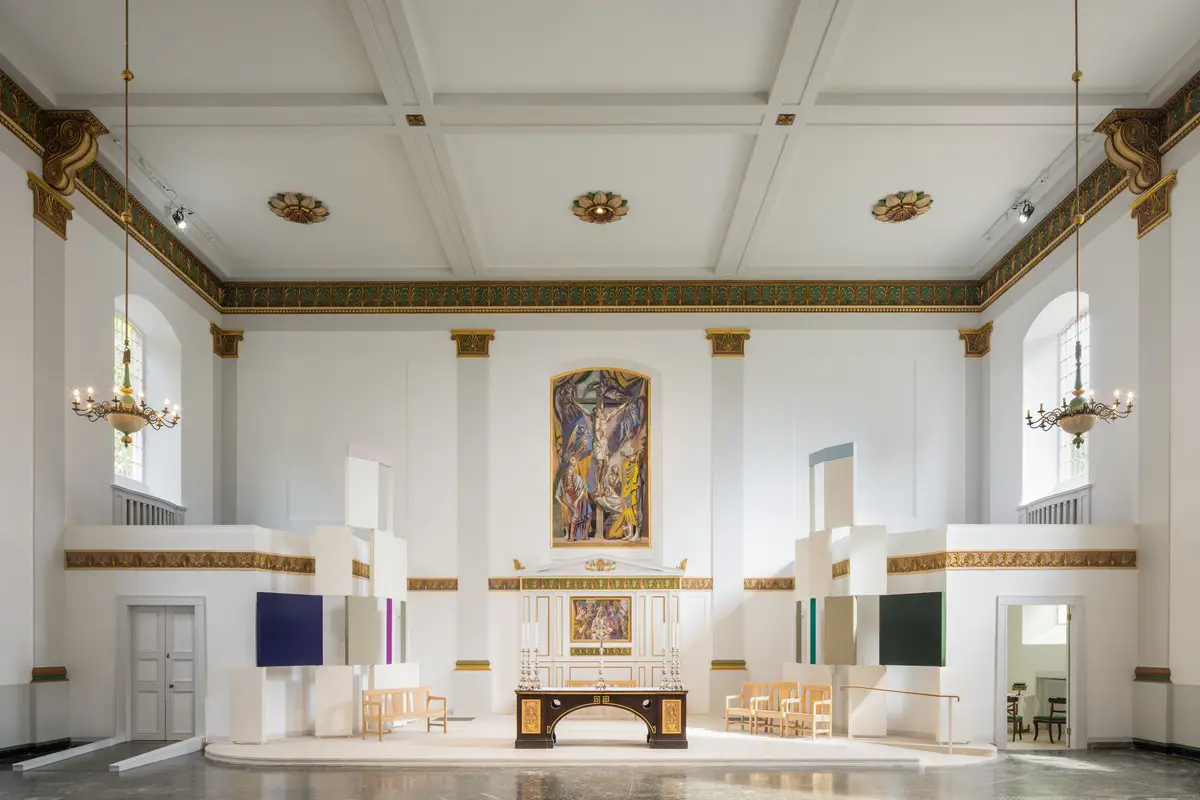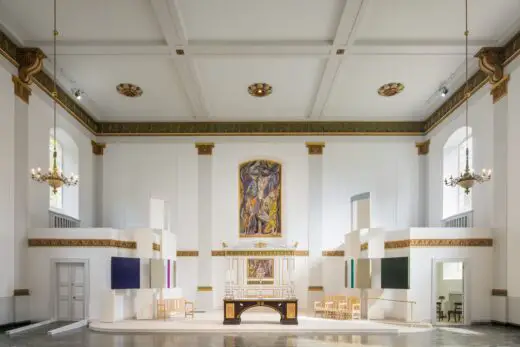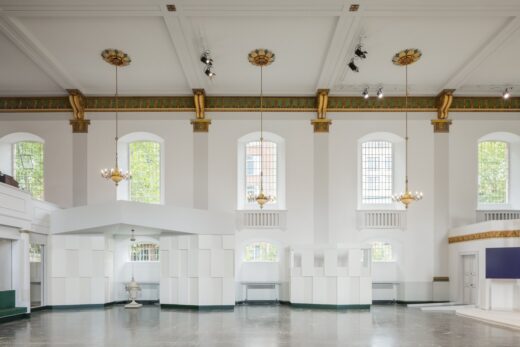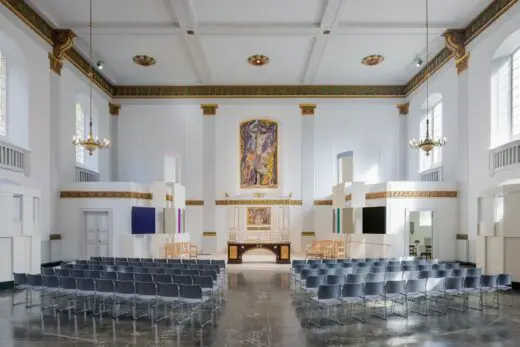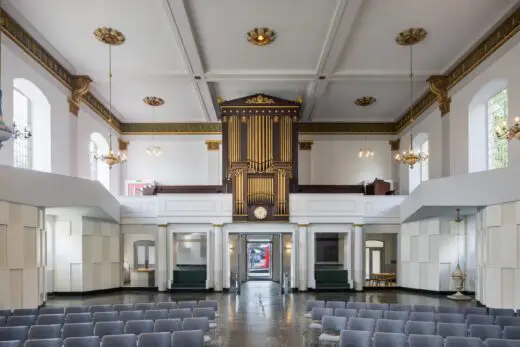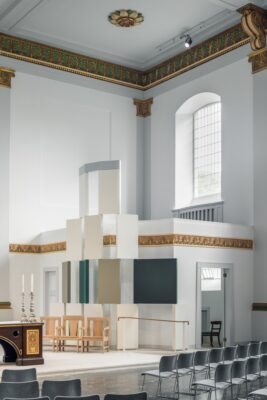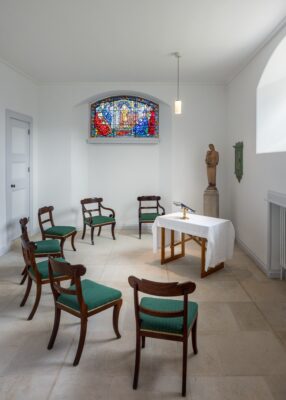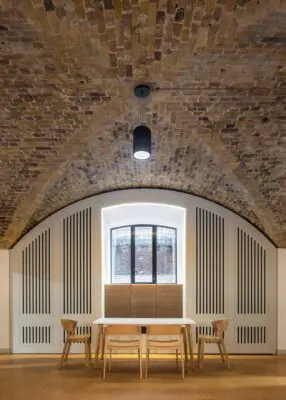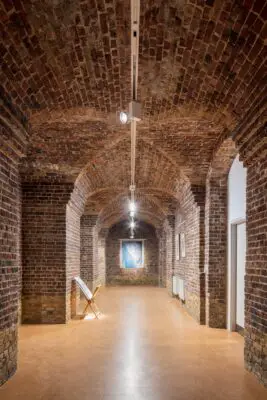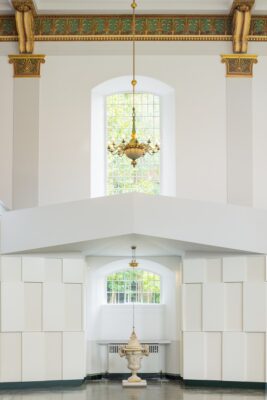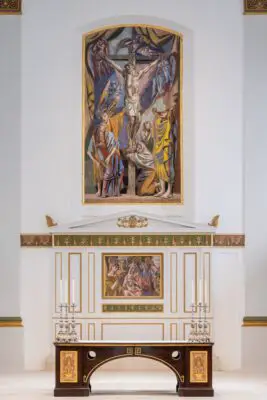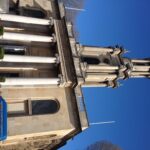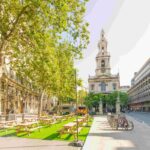St John’s Church Waterloo London building photos, South Bank place of worship news, Location
St John’s Church Waterloo, London
7 October 2022
Eric Parry Architects completes the renovation of Grade II* listed St John’s Waterloo
Design: Eric Parry Architects
Address: 73 Waterloo Road, London SE1 8TY, UK
Photos by Dirk Lindner
• The newly refurbished church provides a place of worship and one of the best performance event and meeting spaces on the South Bank, with accommodation for St John’s own and other community projects, as well as the conservation of the unique church and its art.
• Eric Parry Architects has restored and revealed key elements of the historic interior of the church to create a high-quality space for arts and events within the listed building.
• A major new installation of solar panels provides a potential 30kWh of power generation capacity. Preparatory works for the installation of air source heat pumps help move St John’s towards the Church of England’s commitment to achieve net zero carbon by 2030.
St John’s Church in Waterloo, London News
Eric Parry Architects has completed the £5.5 million restoration and renovation of the Grade II* listed St John’s Church in Waterloo. The improvements to the church will safeguard it as a place for worship and spiritual enrichment, delivering upgrades to its facilities that help it meet its ambition to play a leading role in the social, cultural and spiritual life of Waterloo and the wider city of London.
The project has preserved both the 19th century architecture of Francis Bedford, and 20th century interventions made when the church was restored following wartime bombing and rededicated as the official church of the Festival of Britain under the direction of T.F. Ford. St John’s historically significant altar paintings, by the German-Jewish refugee Hans Feibusch, have been saved by expert conservation and the improved conditions in the nave will support their ongoing preservation.
Eric Parry Architects was appointed in 2010 and worked closely with Revd Canon Giles Goddard, the Vicar of St John’s, to develop a brief centred on the principle of an open welcome, responding to the church’s central commitment to be “here for you”, whoever you are and whatever your needs.
The church entrance has been remodelled, making the nave immediately visible from the street and improving accessibility. A single doorway for all users emphasises an equal and inclusive welcome for all. The installation of a lift makes the crypt fully accessible for the first time.
The vast, open nave has become a much-enhanced worship, event and performance space, with a historically referenced paint scheme. The bold insertion of side panels serves to achieve focus on the sanctuary, setting off the restored Feibusch murals. The panels also provide a new baptistry with the re-sited 1824 font, and a new prayer chapel. In addition they frame a stage for performances and provide a storage solution. Solid oak sanctuary furniture commissioned from specialist ecclesiastical furniture maker Luke Hughes is a centrepiece of the new scheme.
In the crypt, Eric Parry Architects has cleared away temporary modifications from the last 40 years to create a variety of new spaces for community use and hire. In doing so, they have revealed the beauty of the brick vaults and cleaned and restored a long, vaulted chamber known as the Old Crypt.
The crypt will provide a home for St John’s charity The Bridge at Waterloo, from which it will continue to develop its projects for people affected by homelessness and employment training for young people.
The project takes major steps to move St John’s towards the Church of England’s target of net-zero carbon emissions by 2030. Solar energy use has been integrated into design from the outset, with a major installation of 80 solar panels covering almost all the south-facing roof, with the capacity to generate a potential 30 kWh in bright sunshine.
The airtightness of the building has been improved by installation of a new internal lobby space separated from the nave by glass screens, which reduces heat lost to warm air circulation. Replacement of the glazing and repair to the windows in the nave has the dual benefit of improving both airtightness and daylighting levels. Acoustic and thermal insulation has been installed in the ceiling of the Nave, further improving the thermal performance of the building, and double glazed thermally broken windows have been installed in the crypt.
The renovation has taken the opportunity to install heat recovery ventilation units alongside the infrastructure for air-sourced heat pumps to heat the nave, in anticipation of improvements in technology and affordability that will make this viable.
Revd Canon Giles Goddard, Vicar of St John’s, said:
“The renovation of St John’s has been a huge and challenging project seen through with hard work and the utmost dedication of all involved. So it’s thrilling to feel the building coming to life as we reopen. The congregation and the local community are already taking the new St John’s to their hearts as they discover how much more accessible, inspiring and welcoming the spaces are. And we’re seeing the enormous power the church now has to bring people together – in many and sometimes unexpected ways.
“St John’s has served this special part of London since 1824. We were bombed in the war and rebuilt to serve a different Britain in 1951. Once again restored and transformed, we can be here to meet the needs of the diverse communities around us and to play our part in the city for another 200 years.”
Eric Parry, Principal and Founder of Eric Parry Architects, said:
“The conclusion of works at St John’s Waterloo will begin a new chapter in the remarkable life of the church, nearly 200 years after its dedication. St John’s is a place for worship and spiritual enrichment amid the hubbub of one of London’s busiest districts. These renovations enhance the facilities of the church to meet its ambitions of inclusivity, creativity and openness and play a role in the cultural, social and spiritual life of Waterloo.
“The church contains significant heritage from phases of construction in both the 19th and 20th centuries. This most recent renovation preserves and enhances those assets, preparing the church for the post-carbon era by putting in place the infrastructure for net zero carbon operation.
“The St John’s Waterloo project, and our earlier work at St Martin-in-the-Fields in Trafalgar Square, demonstrate the role architecture has to play in creating uses and functions that support the role of the church in the community, provide additional income and secure the long-term future of historic buildings.”
The practice consulted with the congregation, and with community, statutory and local interest groups, including Historic England, Twentieth Century Society, Lambeth LBC and the Church Buildings Council to ensure that the brief and subsequent designs met the complex and overlapping needs of all users of the church.
The project anticipates public realm changes to the wider Waterloo roundabout area, which although currently in consultation, are likely to significantly increase the amount of pedestrian space and ameliorate the impact of traffic at this major road junction.
How St John’s will be used
The finished project balances the daily spiritual life of the church and community with cultural, charitable and commercial activities within the main worship space and the crypt. Space in the crypt has been set aside for a living room for Waterloo – a quiet space where people can sit and relax, meet and mix and get information and support.
St John’s, already a well-known concert venue and home to the Waterloo Festival will now be able to stage a year-round cultural programme. The church looks forward to welcoming many more world-class musicians and to introducing youth, experimental and fringe events of all kinds. Audience members will enjoy the benefits of improved accessibility and acoustics, a new foyer area for receptions and pre- and post-event drinks, and new WCs.
Community and arts organisations will be resident or semi-resident at St John’s, taking advantage of the option to book the new spaces in the crypt and of the possibilities offered by the nave and the shared spaces around the church for formal and casual collaborations. These so far include Waterloo Community Theatre, Futures Theatre and the academy orchestra Southbank Sinfonia.
Eric Parry Architects has also made St John’s Waterloo a highly attractive venue for corporate and private events which are being marketed and delivered by leading South-East event catering and venue management specialist Bovingdons, known for its exclusive catering contracts at Butchers’ Hall, Fulham Palace, Grand Junction at St Mary Magdalene’s and the Museum of London Docklands among other venues. Revenues from events at St John’s will cross-subsidise its charitable work carried out via The Bridge at Waterloo.
Funding
Of the £5.5m of funds raised to complete the renovations, more than £1m came from the congregation – a strong indication of local support for the project. Other major grants came from the London Borough of Lambeth, the Big Lottery Reaching Communities Fund and The Mayor of London’s Good Growth Fund. The solar panel project was made possible by a grant of £30,000 from the Mayor’s London Community Energy Fund. The rest was made up by many other trusts, foundations and individual donors.
St John’s Waterloo
A landmark building just south of Waterloo Bridge, St John’s was built in 1822-24 in the Anglican Greek Revival style, designed by ecclesiastical architect Francis Bedford. In 1940, the roof and interior were destroyed by a bomb. The building was restored by the architect Thomas Ford and re-opened as the Festival of Britain Church in 1951. Its east wall is adorned with murals by the German Jewish refugee artist Hans Feibusch and it is surrounded by an award-winning churchyard garden.
St John’s liberal Anglo-Catholic broad church approach to worship attracts a diverse congregation and it enjoys a reputation as one of the most inclusive churches in London. It’s charity, the Bridge at Waterloo, works with homeless people, young people and the local community. St John’s has a year-round arts programme and runs the annual Waterloo Festival.
St John’s Church Waterloo, London – Building Information
Client: St John’s Church, Waterloo
Architect: Eric Parry Architects
Main Contractor: Buxton Building Contractor
Services Engineer: OR Consulting
Structural Engineer: Alan Baxter Ltd.
Cost Consultant: Academy
Heritage Consultant:Alan Baxter Ltd
Acoustic Consultant: Gillieron Scott Acoustics
Theatre Consultant: CharcoalBlue
Approved Inspectors: Assent Building Control
Fire Consultant: The Fire Surgery
Eric Parry Architects
Eric Parry Architects design and create high-quality, people-focused, sustainable buildings that enhance their surroundings. We listen closely to our clients’ ambitions and needs and collaborate to meet every project’s particular challenges with our most creative and imaginative responses. Architecture should engage with its context and interact with its surroundings to create delight, enjoyment, and well-being for its inhabitants.
The practice is responsible for several highly prestigious commercial projects in London’s City and West End, including Fen Court 5 Aldermanbury Square, 60 Threadneedle Street, 23 Savile Row, 50 New Bond Street, One Eagle Place and 8 St James’s Square. It has also worked on several cultural projects involving the refurbishment or upgrading of sensitive historic buildings. Examples include a significant new wing for the Holburne Museum of Art in Bath and the restoration and renewal project for St Martin-in-the-Fields Church in Trafalgar Square.
In addition to architectural and urban design, Eric Parry Architects has an excellent portfolio of interior design projects, including residential interiors and office fit-outs and is involved in other types of design as well, including bespoke furniture, ironmongery, carpets and textiles. The practice has also worked on successful landscape projects of varying scale and complexity.
www.ericparryarchitects.co.uk
Bovingdons
At 30 years’ young, Bovingdons is one of the South-East’s longest standing catering companies, founded on a passion for good food and stunning events. Today they manage 12 exclusive venue contracts, run seven cafés/restaurants and deliver over 400 events a year. They specialise in good quality, exciting food at a fair price, acting as the trusted partner of beautiful and precious sites.
www.bovingdons.co.uk
Photos: Dirk Lindner
Waterloo Station Masterplan, London Building images / information received 071022
Location: 73 Waterloo Rd, London, SE1 8TY, England, UK
Lambeth Buildings
Contemporary Architecture in Lambeth Area – architectural selection below:
Waterloo International Building, south London, UK
Date built: 1993
Design: Nicholas Grimshaw and Partners
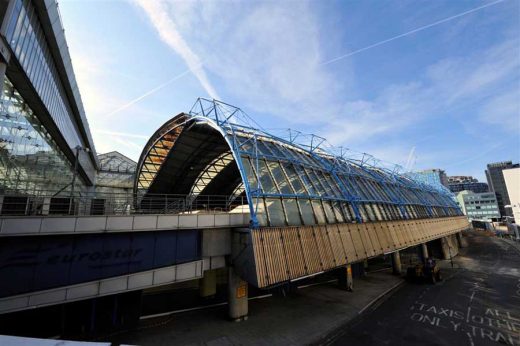
photograph © Nick Weall
Waterloo Station
Waterloo Station York Road Ticket Hall in London
Parliament View
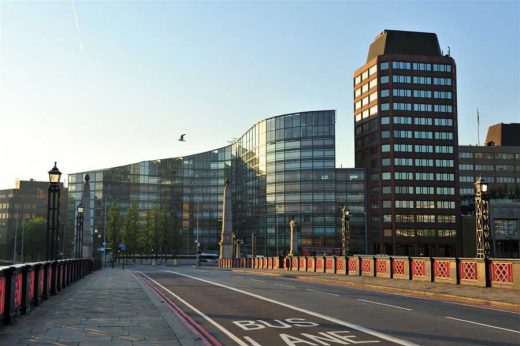
photo © Nick Weall
Parliament View
St Georges Wharf
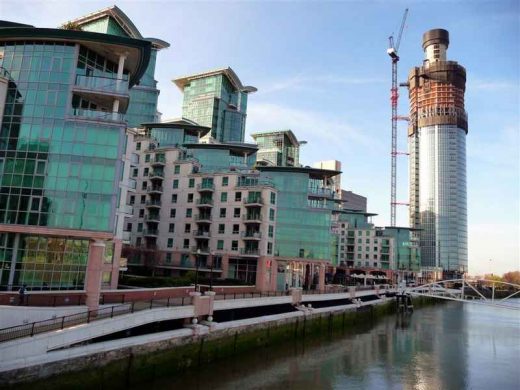
photo © Nick Weall
St Georges Wharf
Westminster Bridge Hotel
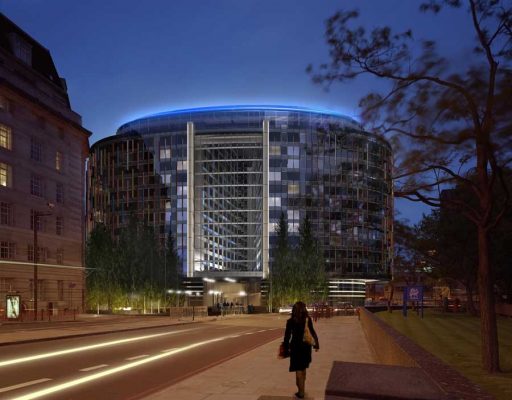
photo courtesy of hotel
Westminster Bridge Hotel
New London Architecture
Contemporary London Architectural Projects, chronological:
London Architecture Designs – chronological list
London Architecture Walking Tours
BFI Imax, South Bank
Waterloo City Square Competition
Comments / photos for the St John’s Church Waterloo London Buildingdesign by Eric Parry Architects page welcome

